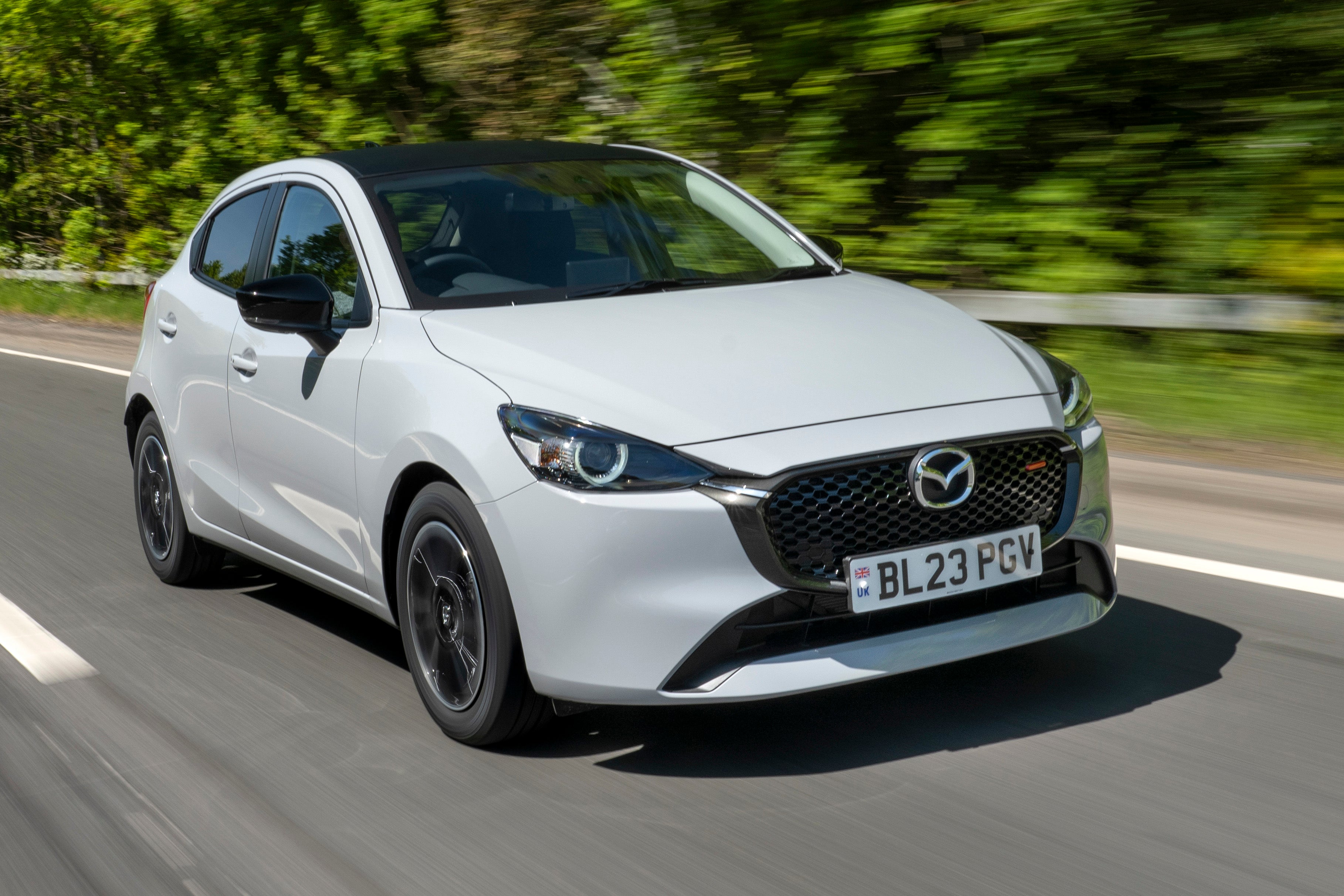Mazda 2 Review 2025: Price, specs & boot space
Written by Andrew Brady
Quick overview
Pros
- Good fuel economy
- Smart interior with bags of kit
- Fun to drive
Cons
- Weedy petrol engines
- Cramped rear seats
- Firm ride in town
Overall verdict on the Mazda 2
"In the incredibly competitive world of small cars, manufacturers are under constant pressure to deliver value for money and sell as many vehicles as possible to maximise profit margins. The Mazda 2 does things a bit differently, hoping to attract buyers with its sharp design, keen handling and premium levels of equipment."
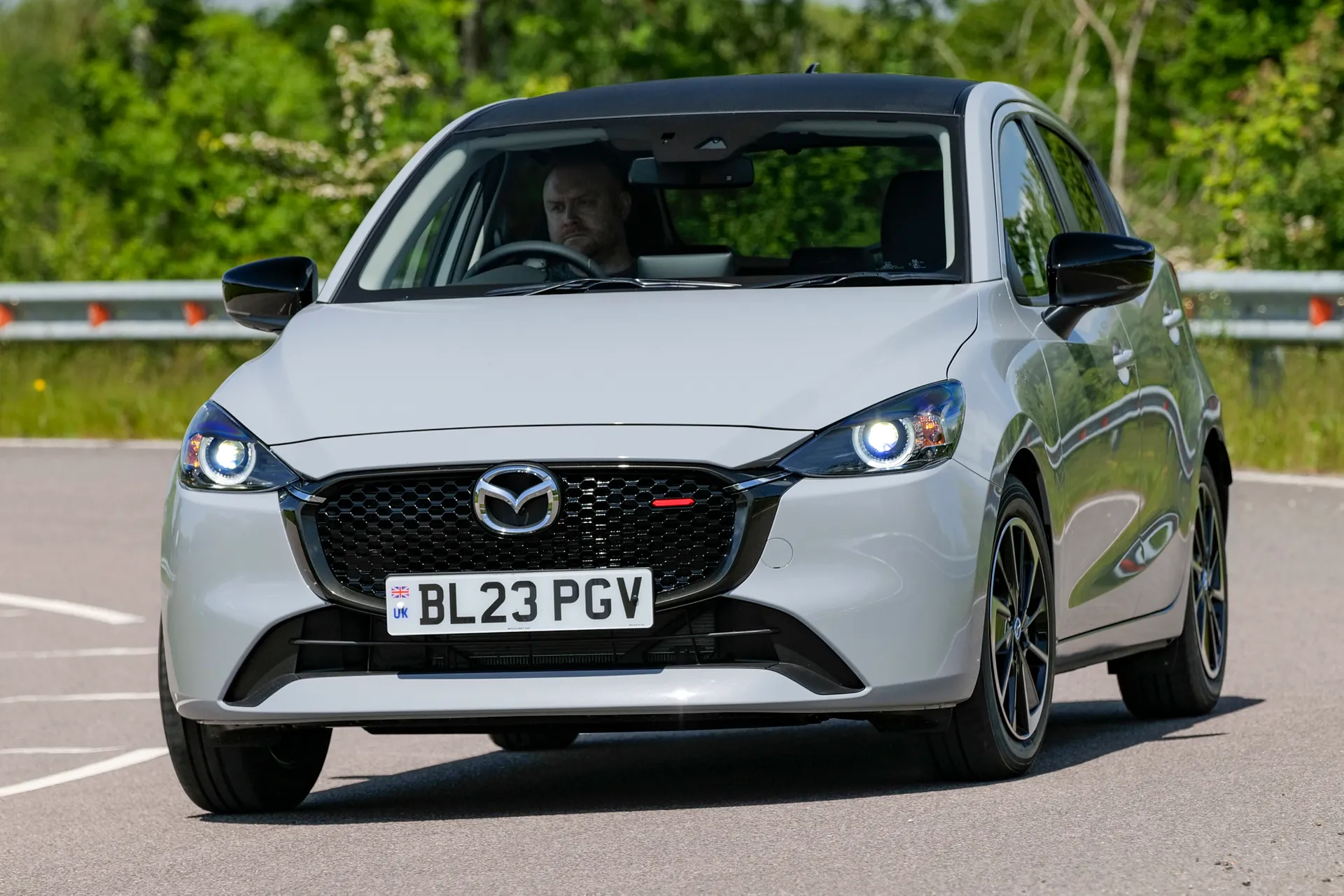
Many of the Mazda 2's rivals are better known (and bigger in all directions), but the comparative rarity shouldn’t put you off this fun five-door small car. The Mazda 2 is frugal, should prove reliable and is decent value.
It has a thoroughly modern media system that's more intuitive and less distracting than most touchscreen setups, with sat-nav, LED headlights, smartphone connectivity and a lot of active safety gear all standard. Build quality is impressive, too, with newer models getting upgraded material trims and comfier front seats.
However, it comes unstuck in the practicality stakes. There is no escaping its compact dimensions, and most small hatches can carry more shopping, luggage and people than you'll be able to squeeze into the dinky Mazda. The boot is well below average for the class, with limited functionality, while the cabin has fewer cubbies, too.
It claws things back a little out on the road. The consistently weighted controls, positive mechanical shift of the six-speed manual gearbox and accurate steering mean it's a good car for weaving through town traffic. The Mazda grips nicely in corners and keeps a tight leash on its compact body, so it doesn't lean or bounce too much.
However, the tidy handling does mean compromised comfort. There is a firm edge to the ride at low speed that never really goes away, and you'll feel small imperfections filtering from the road's surface into the cabin. Cars on larger wheels will jostle you around even more, and combined with so-so refinement, it can be tiring.
Although it was previously available with diesel power, the current Mazda 2 comes with a mild-hybrid 1.5-litre petrol engine in a range of different power outputs. Entry-level cars get a modest 75PS, but the rest of the range benefits from a 90PS version that feels considerably quicker in all driving conditions - there is also the option of an automatic gearbox. There's also a 115PS version if you're after warm-hatch thrills.
Unusually, none of the Mazda 2’s engines feature turbocharging. This means they need to be constantly kept topped up with revs to make meaningful progress, something that's made harder by the tall higher gears. The engines are smooth in town, but quite flat and gutless at low revs, plus they grow coarse once the performance does finally pick up.
This odd character makes the Mazda 2 tricky to recommend. It doesn't feel nearly as premium or grown-up as its big brother, the Mazda 3, inside. Most buyers will prefer the brisk performance and flexibility you get from a turbo engine to this car's strangely gutless 1.5-litre motor.
Looking for a used car for sale? We've got 100s of Mazda Approved Used Cars for Sale for you to choose from, including a wide range of Mazda 2 cars for sale.
Is the Mazda 2 right for you?
The Mazda 2 is on the smaller end of the scale in this class. That means it's great for parking and negotiating the cut-and-thrust of inner-city traffic, but makes it a less practical choice than roomier models from its rivals.
It will suit younger drivers or retirees who rarely need to carry more than two people, but the latter group might not appreciate its firm ride, nor this engine's constant need for revs to make steady progress on faster roads.
Its nicely designed cabin and classy materials do make it feel plush, plus most versions are very generously equipped, too, but the 2 can't quite compete with premium rivals in terms of feel-good factor and perceived quality.
What other cars are similar to the Mazda 2?
The smallest car in Mazda's line-up competes with some of the most popular models in the UK. The likes of the Vauxhall Corsa and Volkswagen Polo dominate sales charts and all are newer than the 2.
The Corsa is a grown-up feeling car that's good to drive and reasonably affordable for the class. The Volkswagen Polo is the comfier option, with excellent refinement and a superbly built interior, even if Volkswagen is a little stingy with its equipment.
For a little less you could pick up practical options like the Skoda Fabia or Hyundai i20, while premium buyers can spend a bit more on an Audi A1 or MINI hatch.
That's before we even mention its pure-electric rivals like the Peugeot e-208, Renault Zoe and Honda e.
Comfort and design: Mazda 2 interior
"The Mazda has a surprisingly sporty interior that feels refreshingly different from the small car norm. The driver-focused cabin has deeply set cockpit-style dials on one side and crisp unbroken lines on the other."
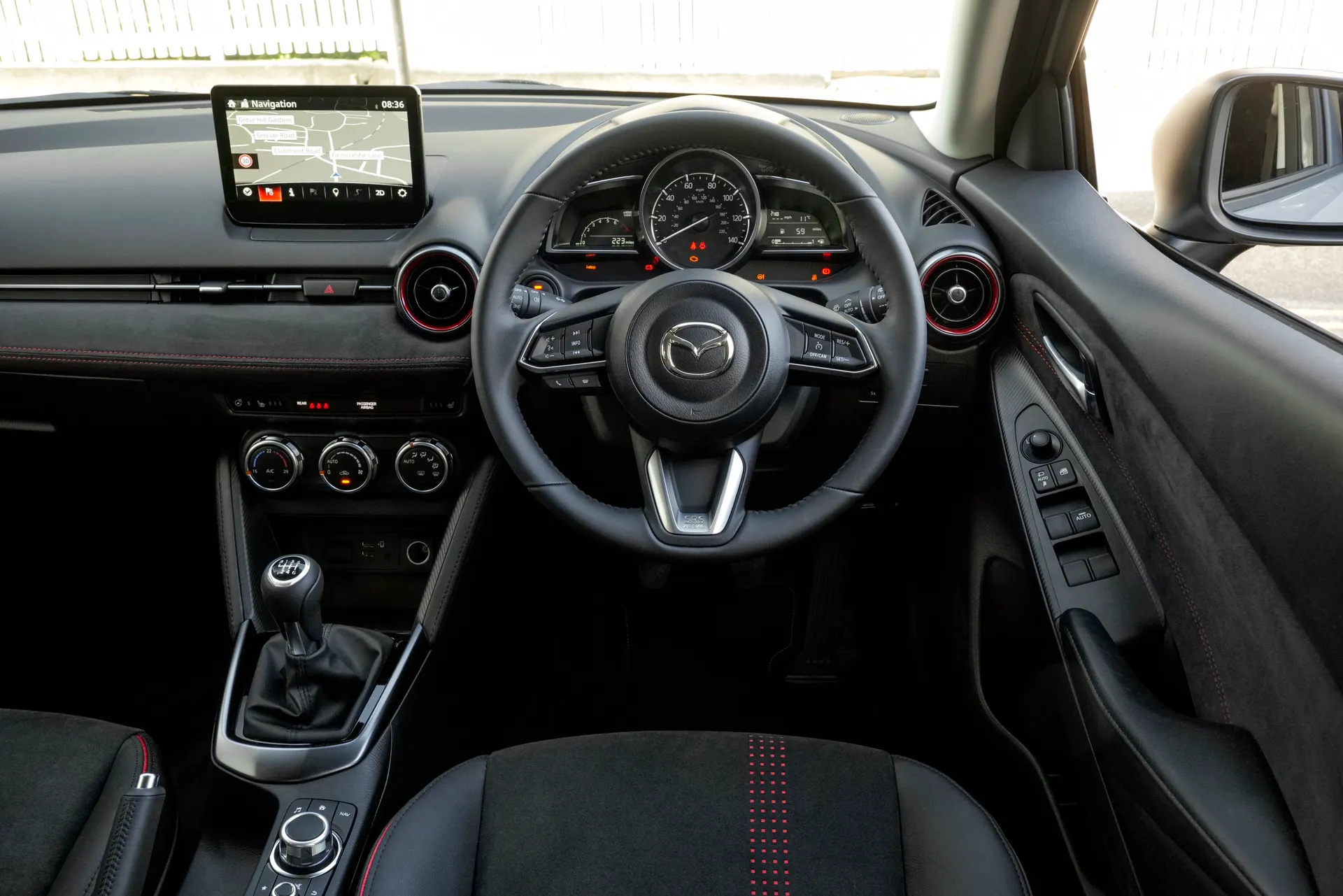
The electric window and mirror switches are canted upwards and placed close to the steering wheel, while the rotary controller for the Mazda Connect media system (where fitted) sits just below the gear selector. The screen itself is mounted very high, so it's easy to read, but that makes pressing the screen a bit of a reach.
Still, chunky climate control dials are easy to set and overall the layout feels very logical. It looks very smart, but the design doesn't come at the expense of usability. In fact, the clean, minimal look just helps enhance it.
We have no complaints about the driving position, with pedals that line-up perfectly with the seats and a full range of manual adjustment for the base, backrest and steering column. No model gets lumbar support, but neither do most of its rivals and Mazda has redesigned its seats to make them more supportive. That's good news for drivers who need to spend a lot of time on the motorway, as the old seats were quite firm.
Forward visibility is fine, but the sloped roof impedes the view out of the back. We're glad to see that Mazda now fits rear parking sensors across the range, while top-spec cars get a reversing camera.
Quality and finish
The Mazda is certainly not the cheapest small car on sale, but it does feel suitably premium inside, especially in later examples. Previous problem areas like the flimsy manual air-conditioning controls, the hood of the instruments and the door cards have been improved in terms of the materials used. You now get nicer finishes in these areas, with a pleasing mixture of glossy, soft-touch and silver-finished plastics, plus a nicely sculpted leather steering wheel that feels sturdy.
There are still some tell-tale signs of cost-cutting, including the cheap black plastic covers for the USB ports, but everything seems robust and fits together really nicely, with tight shut lines between the dashboard panels.
Infotainment: Touchscreen, USB, nav and stereo in the Mazda 2
On older, lower-spec Mazda 2 models, you get a monochrome AM/FM radio with just four speakers, a CD slot, and USB and AUX ports - welcome to the 90s. The basic system does at least have Bluetooth, and lets you control the volume and track selection with buttons on the steering wheel.
The thing is, the cabin layout has been designed for the upgraded touchscreen, so the radio is mounted a bit too far back on the dashboard to reach without stretching, and the actual controls are really slim and fiddly to use.
We would avoid this system if you can. Later models (and those with 'Nav' in the name) feature a 7.0-inch colour display, which brings with it DAB digital radio, navigation with live traffic updates plus Android Auto and Apple CarPlay phone mirroring. It's not the sharpest screen and the menus take a little getting used to, but it's miles better than the basic setup. The screen was later upgraded to an 8.0-inch item.
You also benefit from six speakers, better sound quality and an extra USB for charging two devices at once. It's a no brainer and we really like the fact that Mazda gives you a rotary controller to navigate its menus, because it's less distracting to use when driving than a touchscreen.
Space and practicality: Mazda 2 boot space
Small cars need to be good all-rounders, but unfortunately, cabin space is an area the Mazda fails to shine in. It's simply not as spacious inside the back seats or boot as the class leaders, limiting its range of practicality.
We're talking fine margins of course. You can still fit adults in the rear and every model has five doors, but if your passengers are long-limbed, they may find their knees resting on the backs of the front seats. There is less headroom than in rivals, too, and the small windows make it feel cramped.
The body is narrower than most, so trying to squeeze three into the back will involve an impromptu game of twister as everyone tries to dig out their seat belt buckles from under each other: we wouldn't recommend it. There's a less-than-ideal amount of storage, with no door pockets, one map pocket to share and no cupholders in the back.
Up front, there is more room to stretch out, with enough space to accommodate all shapes and sizes. Again, though, there are some niggles. The door pockets are small and hard to access, while the cubby behind the gear knob is too slim for a smartphone or even a chunkier wallet. Apart from loose change, it's redundant.
It's a similar story in the boot. Overall capacity is 255 litres, which trails most other small cars and it's harder to load bulky, heavy items than it would be in those rivals. It has a high load lip to contend with and there is no false floor option to flatten out the luggage area when you've stowed away the 60/40 split/fold rear seats.
The opening you actually have to lift things through is narrow, too, which means you have to carefully place longer heavier stuff to avoid scratching the paintwork. It can carry 950-litres in two-seat mode, which would be quite impressive for a city car, but makes the Mazda 2 one of the least commodious small hatchbacks on sale.
That might not be a deal-breaker, but for those who do need space, a Skoda Fabia or Citroen C3 is a better choice. Fact fans, take note. The Mazda 2 measures 4070mm in length, 1695mm in width and 1515mm in height.
Handling and ride quality: What is the Mazda 2 like to drive?
"Mazda is the brand that builds the MX-5 sports car, and as such, it's known for fun driving dynamics. The little 2 uses the same philosophy and tries to put its driver at the centre of the action, turning every trip into an event."
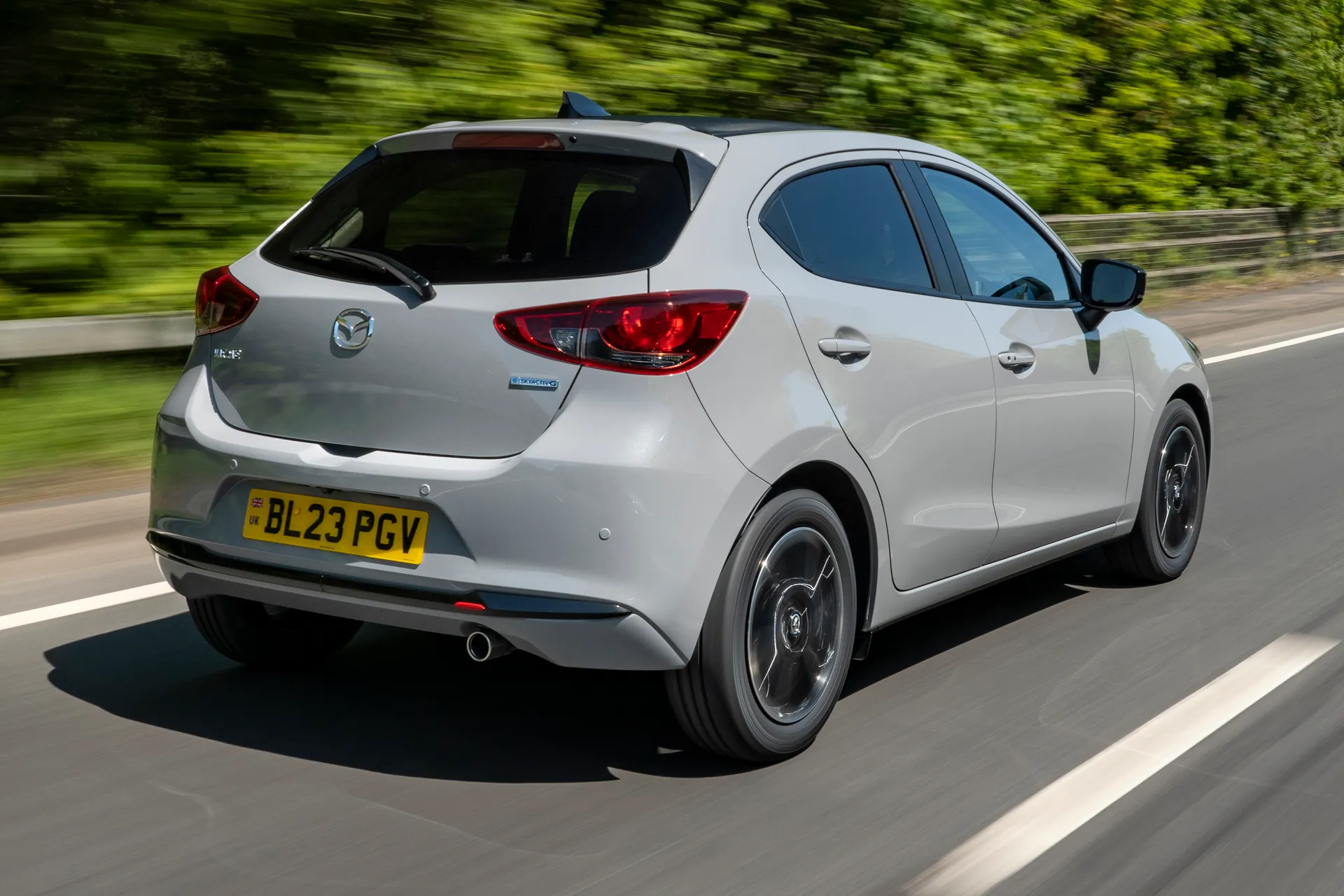
The Mazda 2 has all the traits you'd want from a sportier model, with strong cornering grip and nice accurate steering that's a touch heavier than in most competitors, while body movements are kept neatly in check as the car changes direction.
The Mazda feels light (because it is) and stays planted when you tackle challenging roads, and this sensation of stability gives you plenty of confidence at the wheel. It also doesn't float or bounce like some small cars.
However, it also has some qualities that are less welcome in a sensible small hatch. The ride is on the firm side and if you choose a higher-spec model with larger 16-inch alloys, rough roads will send a buzz of vibration up inside the cabin.
It stops just short of being uncomfortable, and with relatively high-profile tyres fitted as standard, it does do a decent job of dealing with obstacles like speed humps, but it's smaller imperfections that it won't filter out as well as rivals. We would advise sticking with the more basic models if you want to help alleviate some of this firmness in town.
The steering is also a bit numb and the Ford Fiesta (now off-sale but in plentiful supply on the used car market) is sharper to drive and more comfortable, which makes you wonder what you actually gain from Mazda's sporty approach apart from an unnecessarily fidgety ride.
What engines and gearboxes are available in the Mazda 2?
One thing that Mazda does differently to other car firms is the clever use of something it calls ‘SkyActiv’ technology to boost fuel economy. This means that it uses larger engines than most other small cars and doesn’t feature turbos. Indeed, the 2 posts some very impressive official WLTP figures, and it's likely to get a lot closer to them on a regular basis than a highly tuned, smaller-capacity turbo engine.
This approach gives the 2 a very different character from most rivals. It now comes with one engine, a 1.5-litre petrol, available with 75PS, 90PS and 115PS, with or without mild-hybrid assistance.
Those power figures are modest compared with pricier versions of the Fiesta (140PS) and Corsa (130PS), and the Mazda makes you work for every ounce of performance. You have to rev the engine hard to get it going, and while it feels willing and eager to do so in the mid-range, at lower revs it feels flat and breathless.
Unless you rarely venture out of town, we'd go for the 90PS model, but don't expect many fireworks. Its six-speed manual gearbox has very long ratios, and while that's good for cruising, it also means you can put your foot right to the floor in fifth or sixth gear and the car will barely move any faster.
On the plus side, the gearchange is wonderfully positive. All that's required to slot between the gears is a flick of the wrist, so at least you'll be having fun as you constantly shift. You can add a six-speed automatic to this version, but it accelerates even slower than the manual model.
Refinement and noise levels
Small cars like this one often struggle to suppress wind- and road noise, purely because there's less metal between you and the scenery rushing past outside. Unfortunately, the Mazda holds true to form in this area.
On the motorway, it's less peaceful than a SEAT Ibiza or Ford Fiesta. Wind noise is kept at a reasonable level, but the rumble from the tyres gets pretty intrusive, especially on cars fitted with larger 16-inch alloy wheels.
Since its engine is down on torque compared to the three-cylinder turbos common in its rivals, it can be hard to keep the revs down. Once they climb past 4000rpm, the motor adds its coarse voice to the rising hubbub.
That's a pity, since at low speed the 1.5-litre unit is so smooth that it's often difficult to tell if it's even running. All cars now get a six-speed manual gearbox as standard. It's slick and really precise to use, but tall gearing and general lack of puff mean you'll be making a lot of changes to try and keep the engine in its sweet spot.
If you're not up for the workout, the optional six-speed automatic on the 90PS motor is a smooth operator. It doesn't benefit from the mild-hybrid system you get on the manuals, though, so its a lot thirstier and the start-stop system is not as slick.
Safety equipment: How safe is the Mazda 2?
Keeping you protected in an accident is just as important in a small car as a bigger one - arguably more so. It's not ideal then, that the Mazda 2 received only four out of a possible five stars when it was tested by Euro NCAP back in 2015.
It got decent individual scores for adult and child protection, although the Renault Clio, Ford Fiesta and Volkswagen Polo all do even better in the former category, helping to secure that extra star. The main issue is that base-level models miss out on important active safety systems that cannot be added, even as part of an optional pack.
The brand has fitted a more generous level of safety gear to the rest of the range. Every other model comes with lane departure warning and a lane keep assistant, plus auto-emergency braking.
All cars feature rear parking sensors, which should help mitigate unwanted low-speed prangs, and cruise control that includes a speed limiter function, ensuring you stay below the legal maximum. All very sensible.
While it's not possible to enhance the protection or assistance on board with optional extras, there are a few items of equipment reserved for the most expensive GT Sport Nav (later GT Sport Tech, and later still, Homura Aka) model. It gets a driver tiredness monitor, a blind spot monitor, and a head-up display, which projects key driving information onto a pop-up screen above the normal dials.
Another point to bear in mind about that Euro NCAP rating. The body's tests get harder and harder every year in the pursuit of ever-increasing safety standards, and with the 2 having been tested way back in 2015, it will have been tested against standards and thresholds that were nowhere near as stringent as they are today. Indeed, these ratings only stand for a five-year period before the body deems them irrelevant, at which point the ratings expire. So, if the 2 was below-par for crash safety in 2015, it's likely to be a lot less competitive now.
MPG and fuel costs: What does a Mazda 2 cost to run?
"If you want a fine layer of dust to gather on your fuel filler cap and to drive hundreds of miles between stops, the discontinued 1.5-litre diesel will be your efficiency champion. Although it claimed to achieve over 80mpg, Real MPG owners on HonestJohn.co.uk recorded a (still impressive) average of 67.3mpg in mixed everyday driving conditions."
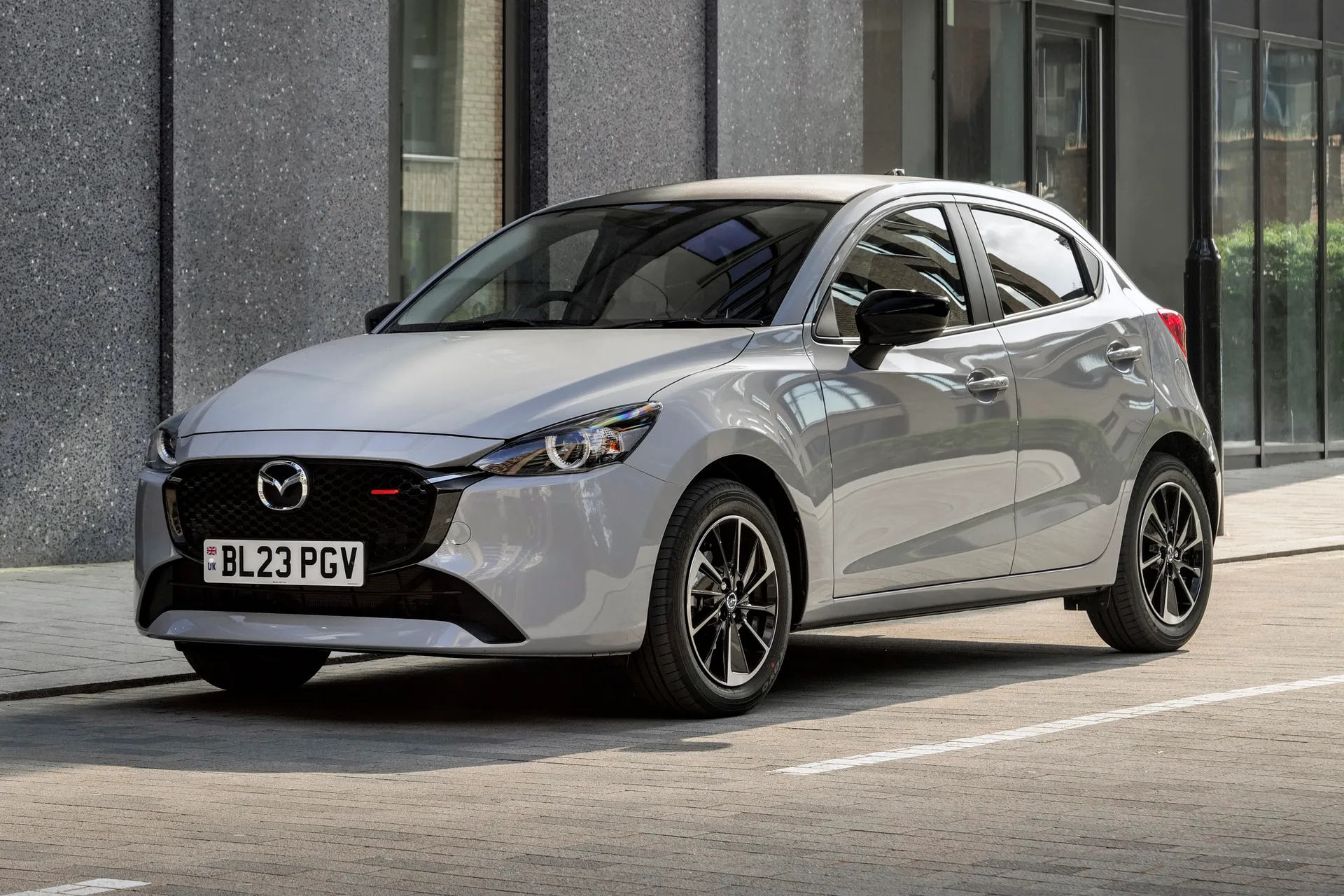
Even with the introduction of new mild-hybrid technology in 2020, the current line-up of modern petrols can't match the older diesels. There's a reason diesels are unpopular in small cars, though: aside from the obvious image problem, they're too expensive and aren't really suited to regular town driving.
The most efficient Mazda 2 currently on sale is the 90PS 1.5-litre mild-hybrid with the manual gearbox. This officially returns 60.1mpg in WLTP fuel economy tests, and that actually makes it the most efficient purely petrol-powered car on sale today. Without mild-hybrid assistance, the same engine with the automatic gearbox returns 52.3mpg, while the entry-level 75PS unit manages 58.9mpg. The 115PS e-Skyactiv G mild-hybrid has a combined figure of 56.5mpg.
How reliable is a Mazda 2?
Mazda generally has a good (if not exceptional) reliability record – although we have heard of a few build quality issues with the Mazda 2. These includes squeaks and rattles from the cabin, while a few HonestJohn.co.uk readers have reported gremlins with the infotainment system. Rusty suspension parts are quite common, too.
Insurance groups and costs
Insurance companies make some calculations based on engine size, so although the Mazda's 1.5-litre unit doesn't pack the biggest punch, it will cost you more than smaller-engined rivals with similar power outputs.
Even the cheapest 75PS model sits in Group 13, a few bands higher than a Volkswagen Polo and a massive eleven more than a Skoda Fabia with identical oomph. The 90PS model starts off in Group 15, while the quickest 115PS version will be off-limits for inexperienced drivers or those with a patchy record, as it's up in Group 19.
VED car tax: What is the annual road tax on a Mazda 2?
Before the rule changes made to the system in April 2017, taxing your Mazda 2 was a painless experience. It emitted less than 120g/km across the range, so the maximum it would set you back was just £30 every year.
Later models now have to pay the same £190 flat-rate of tax as all other petrol cars, regardless of emissions.
How much should you be paying for a used Mazda 2?
"You might get more choice if you're in the market for a used Ford Fiesta or Volkswagen Polo, but there are still plenty Mazda 2s to choose from. In our listings, prices for the earliest examples start from around £8000 or £9000."
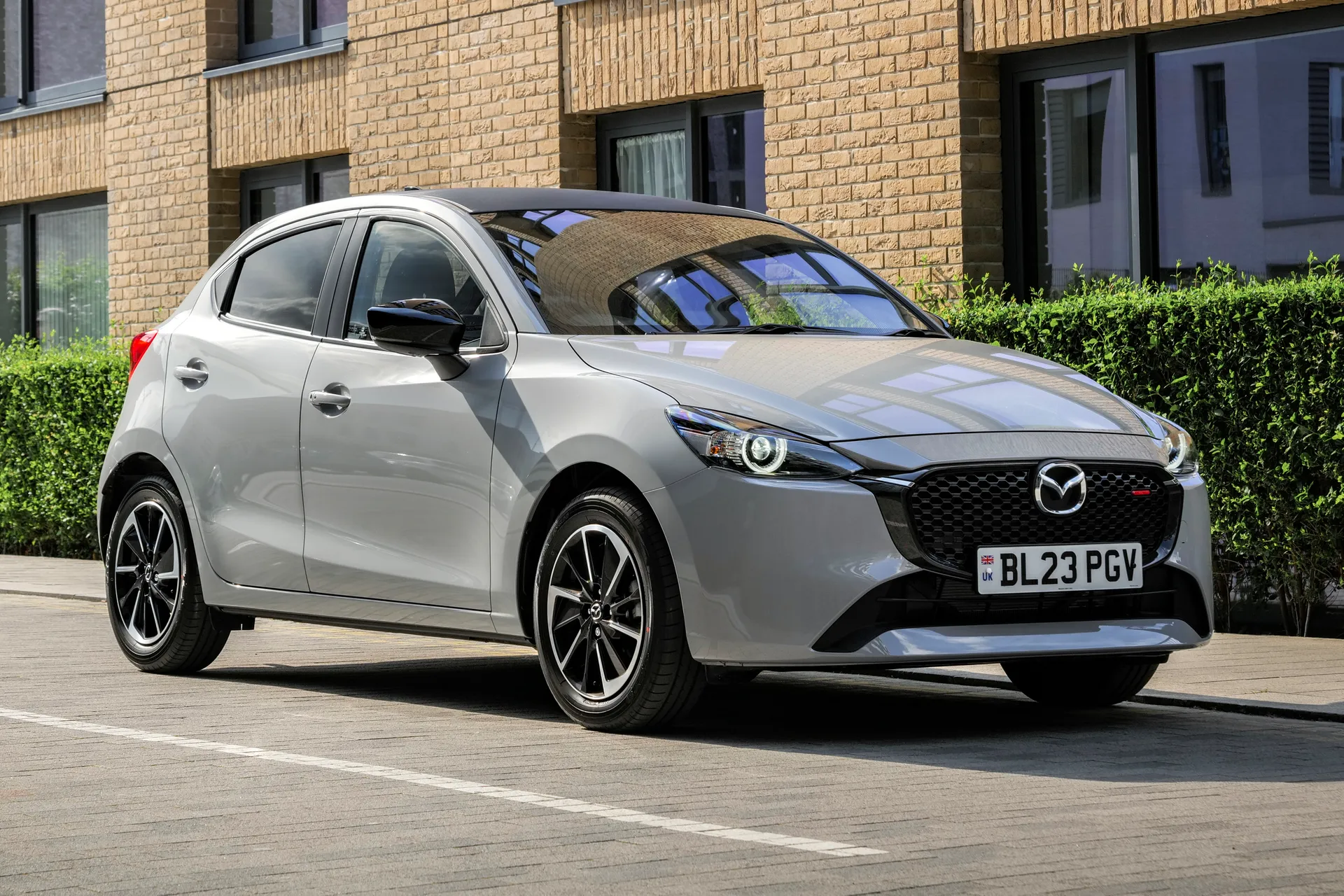
Most of the cheapest cars will feature the weakest 75PS version of the 1.5-litre petrol engine, but the 90PS motor can be had for the same money. Most are mid-spec trim levels, too, and you're most likely looking at a 2017 or 2018 car wearing between 30,000 and 45,000 miles.
Trim levels and standard equipment
The Mazda 2 trim line-up has changed a number of times over the years, and there have also been a large number of special edition models offered over time with weird and wonderful names. In fact, at last count, we think there have been no fewer than 25 separate trim versions of this car over the years.
Currently, the trim versions available are Centre-Line, Exclusive-Line, Homura and Homura Aka.
Centre-Line trim comes pretty well equipped, with 15-inch alloys, climate control, automatic lights and wipers, reversing sensors, power folding door mirrors, cruise control, electric windows and the full infotainment system with 8.0-inch screen. That's if you pair this trim with the 75PS engine: upgrade to the 90PS unit, and you also get lane departure waning, lane-keep assist and automatic emergency braking.
Exclusive-Line trim can only be had with the 90PS engine - manual or automatic - and this comes with larger 16-inch wheels, rear privacy glass, a reversing camera and smart keyless entry. Homura trim forgoes a few of those items in favour of sportier styling. Homura Aka, meanwhile, adds part-leather seats with three-stage heating up front, plus a heated steering wheel. Pair Homura Aka trim with the range-topping 115PS engine, and you also get front parking sensors, 360-degree cameras, a head-up display, blind spot monitoring, and rear cross traffic alert with brake intervention.
Before that, the range was made up of four key models: SE-L, Sport, GT Sport and GT Sport Tech.
Standard equipment on the Mazda 2 SE-L includes a 7.0-inch sat-nav (with Apple CarPlay and Android Auto), brown cloth seats with black inserts and a leather steering wheel. LED headlights are also standard, as well as rear parking sensors, cruise control and 15-inch alloy wheels. Buy an SE-L with the mild-hybrid engine and it'll also come with an emergency braking system, lane departure warning and lane-keep assist. Not too shabby for an entry-level car.
For a sportier look, the Mazda 2 Sport adds tinted windows, a chrome exhaust trim, black radiator grille and 16-inch alloy wheels. You'll also find smart keyless entry and wireless Apple CarPlay.
The Mazda 2 GT Sport features a reversing camera, blue/grey leather, heated steering wheel, heated front seats and a colour head-up display. Sitting at the top of the range, the Mazda 2 GT Sport Tech adds front and rear parking sensors, adaptive LED headlights and a 360-degree camera. A blind spot monitoring system (with rear cross traffic alert) is standard, as well as a rear smart city brake support system and driver attention alert.
In the past, there were five different trim levels: SE, SE-L, SE-L Nav, Sport Nav, and GT Sport Nav.
The old Mazda 2 SE was quite basic, with air-con, but winding electric windows, steel wheels and little else. We won't be mourning its loss, and the SE is best avoided if you're shopping used, even though it's cheap.
If you're on a budget, we'd look for a Mazda 2 SE-L, which comes positively stuffed with kit. LED headlights, alloy wheels, rear parking sensors, automatic lights and wipers, cruise and climate control, all it's missing is a big touchscreen.
Of course, that's exactly what you get when you upgrade to the 'Nav' version, along with a properly modern infotainment system that includes DAB radio, Apple and Android smartphone pairing, and sat-nav.
Mazda 2 Sport Nav adds some sleeker LED headlights with integrated day lamps, 16-inch alloys, darker privacy glass, and keyless entry. Meanwhile, top-spec cars feature a reversing camera, head-up display, plus heated leather for the seats and steering wheel.
As we said, there have been tonnes of special editions over the course of its life too. Most are more about a few styling tweaks or exclusive colours like red or black, and not an increase in the amount of equipment on board.
Ask the heycar experts: common questions
Is the Mazda 2 a good car?
Is the Mazda 2 a Ford Fiesta?
Is the Mazda 2 made in Japan?
Get our latest advice, news and offers
Keep me updated by email with the latest advice, news and offers from heycar.
By submitting you agree to our privacy policy
